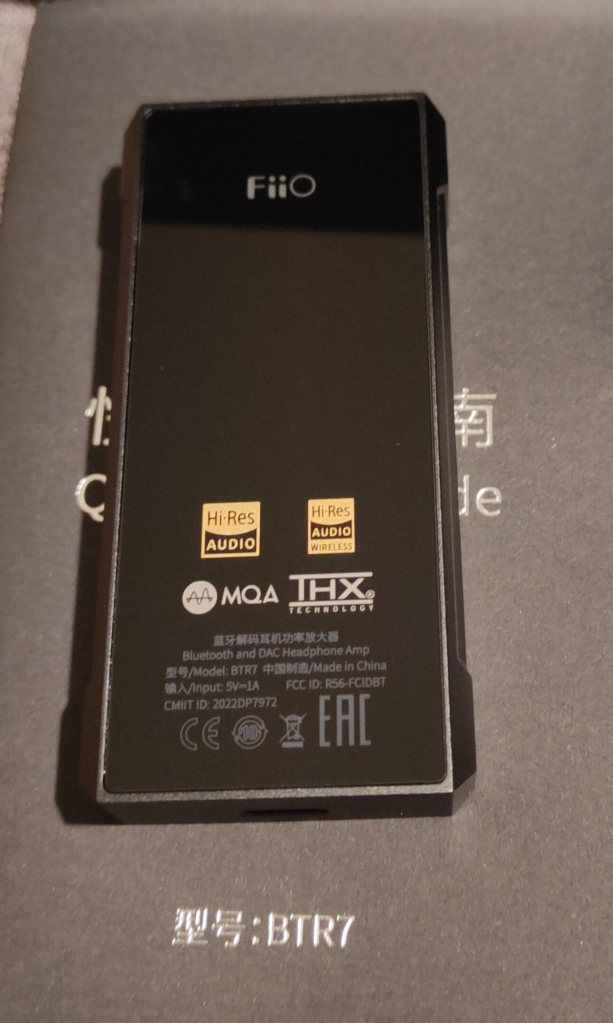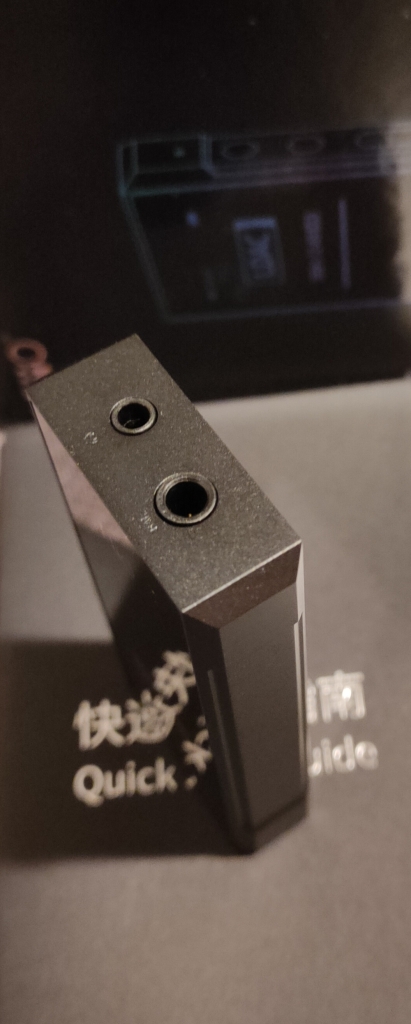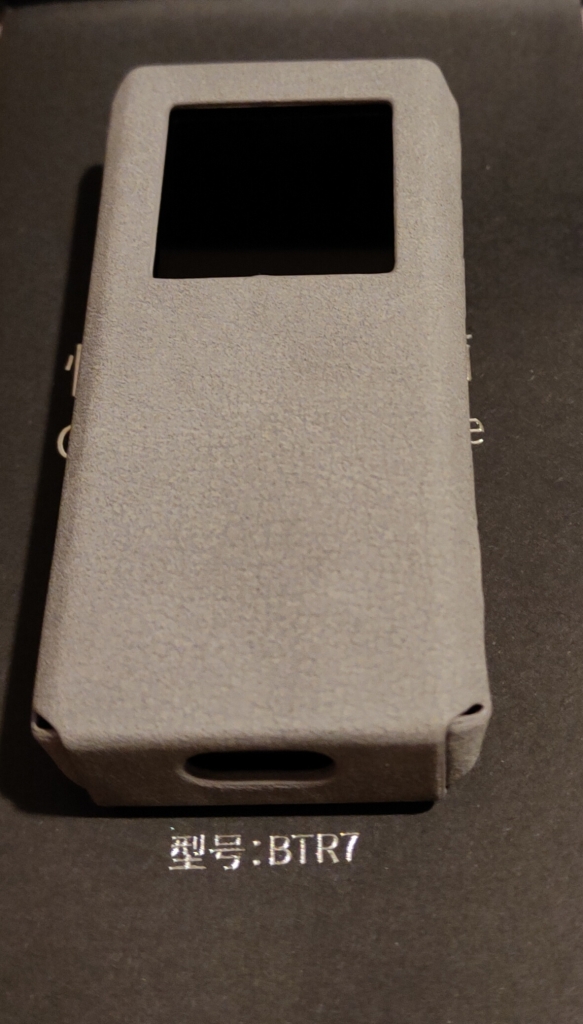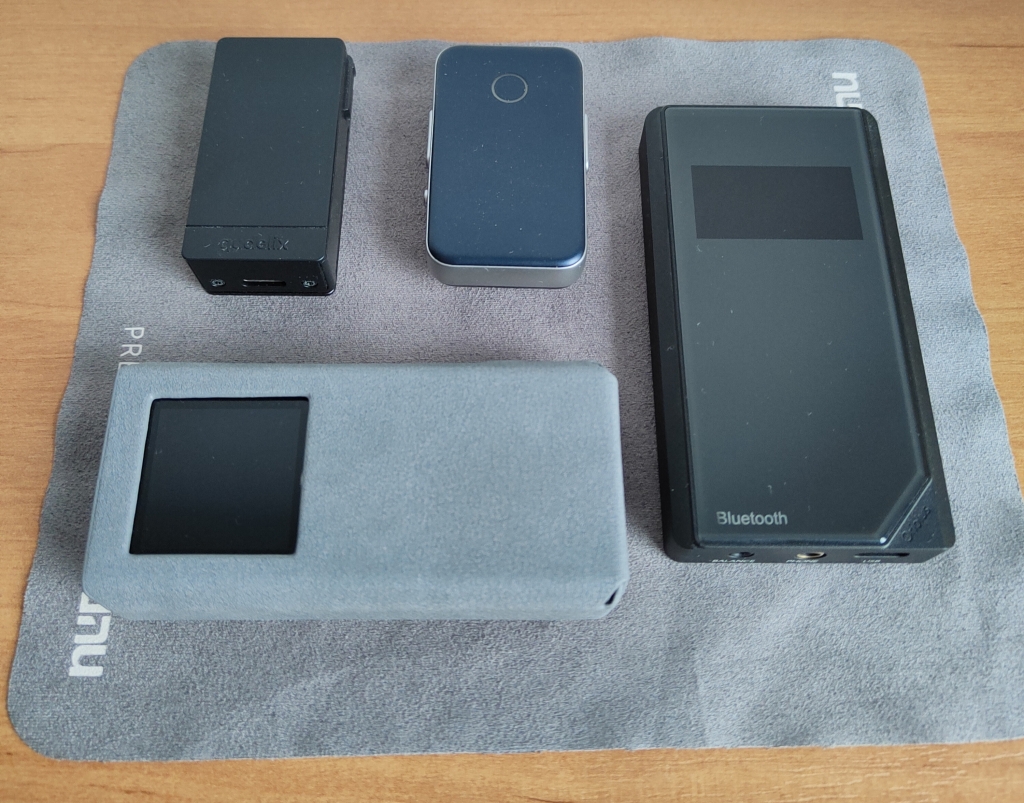Item information
- Category
- Portable Amps
- Added by
- Wasaabi
- Views
- 25,469
- Watchers
- 18
- Comments
- 3
- Reviews
- 8
- Last update
- Rating
- 4.63 star(s) 8 ratings
-
Questyle M12i — Mobile DAC/AmpThe Questyle M12i comes as a successor to the highly-acclaimed M12 that came out in 2021, with...
-
Questyle M15i — Mobile Headphone Amp & DACThe Questyle M15i is the second-generation, MFi certified update to our award-winning high...
-
Questyle CMA18 Portable / CMA18PThe CMA18P was designed to create a Hi-Fi system for smartphones and laptops, aiming to achieve...
-
PENON OS133 Type-C to 3.5mm Audio/4.4mm DAC/AMPPENON OS133 Type-C to 3.5mm Audio/4.4mm DAC/AMP
-
HiBy W3 II Bluetooth CS43131 DongleThe HiBy W3 II is HiBy second iteration of the W3 dongle DAC featuring a single CS43131
-
QDC Dmagic SoloDmagic Solo is a high-sensitivity full-frequency single-dynamic-driver earphone based on the...
-
Acoustune HS2000MXAn IEM made in Japan
-
FiiO/Jade audio JH3A 1dd+2ba hybrid IEM from FiiO/Jade Audio.
-
DUNU Titan SA single DD IEM
You are using an out of date browser. It may not display this or other websites correctly.
You should upgrade or use an alternative browser.
You should upgrade or use an alternative browser.
Latest reviews
MrDAndy
New Head-Fier
Pros: very clean, resolving, neutral
Cons: app is not user friendly
There's nothing to say on sound other than it is transparent. Perfect. Pure bliss. Very silent and very distortion free. A true high fi piece of gear at an outstanding quality. The bad news is you need eq to make it sound good as with all neutral gear.
You have now 3 slots for peq (parametric equalizer) in app that can be memorized with a preset. Unfortunately you can't name them so you have to remember which is which when you change headphones. UI as an experience is a little frustrating, there's nothing difficult, it just is not the smoothest of the experiences. Peq only works with peak filters (10 bands which is ok) and I get the feeling by ear that it accepts only integer gains (eg 0.2 becomes 0, but also 0.7 becomes 0. You might want to try and round them up..). The app is a work in progress so it might get better when you'll read this. The most practical solution: load your target for your headphones on autoeq.app (for the majority of people the standard target works just fine), select personalized peq and put in ten peak filters. Let autoeq do its magic while you take the quickest coffee of your life. Put the data gathered in this way inside the Fiio app. Boom. Great sound.
Great quality product, solidly recommended, it gives me a lot of pleasure.
You have now 3 slots for peq (parametric equalizer) in app that can be memorized with a preset. Unfortunately you can't name them so you have to remember which is which when you change headphones. UI as an experience is a little frustrating, there's nothing difficult, it just is not the smoothest of the experiences. Peq only works with peak filters (10 bands which is ok) and I get the feeling by ear that it accepts only integer gains (eg 0.2 becomes 0, but also 0.7 becomes 0. You might want to try and round them up..). The app is a work in progress so it might get better when you'll read this. The most practical solution: load your target for your headphones on autoeq.app (for the majority of people the standard target works just fine), select personalized peq and put in ten peak filters. Let autoeq do its magic while you take the quickest coffee of your life. Put the data gathered in this way inside the Fiio app. Boom. Great sound.
Great quality product, solidly recommended, it gives me a lot of pleasure.
Mataudiophiles
New Head-Fier
Pros: Music quality, purity, power, amplifier mode, exquisite workmanship.
Cons: Nothing.
Fiio BTR7

Prelude:
Fiio takes perfection quite seriously in the pursuit of transparent and pristine sound. I remember perfectly the strong and decisive sound of the BTR5 and the even better sound of the BTR52021. However, it was not enough and Fiio decided to go even higher, creating the most advanced and at the same time the highest priced DAC/AMP receiver on the market. This is how one of the most ambitious Bluetooth projects in recent years, BTR7, was created. It was supposed to be not only an extension of the BTR series to a flagship position, but also to give a solid signal to the competition that Fiio is not giving up its leadership position. The new project is based on the same transducers as the predecessor, but a completely new THX amplifier section, a 4.4 mm output, and a completely new USB system from Xmos have been added.

Unboxing and ergonomics:
Now that we have the introduction behind us, it’s time to move on to the next stage. The price of the new BTR7 is currently USD 199, so it is higher than BTR5 or other competitive solutions. In return, we get a nice cardboard packaging with the device itself, documentation, a USB-C to USB-C cable and a USB-to-USBC cable, as well as a nice and functional case made of gray suede-emitting material. Fiio BTR7 includes completely new components in the amplifier and USB sections, and the power from both the SE and BAL outputs has also increased significantly. As performance increased, the size and weight of the device also increased. It is already the size of a small DAC/AMP, but the parameters still do not exceed the concept of mobility and functionality. However, we must take into account that we will not attach the BTR7 to a T-shirt or sweatshirt, but we can still easily fit it in a pocket or even in our hand. The whole thing is made of a solid aluminum frame and two panes of glass. On the front there is a nice color display, unfortunately it is LCD, but its readability is very good even on sunny days. Additionally, we have a power button, volume control and a function button, as well as a microphone and a switch to turn on or off the charging of the device. The ability to power the BTR7 only from the built-in battery is a great solution and I really like it, it’s a pity that we can’t completely bypass the battery power supply and use an external power supply, but at the same time the battery still provides a much more stable current.

Battery and power supply:
As I have already mentioned, BTR7 can operate as a full-fledged DAC/AMP, both using the built-in battery and charging via the same cable used for data transmission. In DAC/AMP mode, it supports both UAC 1.0 and 2.0 modes and supports all popular Bluetooth codecs, including native MQA. This is a significant advantage over the competition, which at best reaches 92khz/24bit. Wired, the BTR7 sound is smoother and more resolved, with less compression. As for the battery, in real use with FLAC files and the LDAC codec and Tin P1max headphones, I achieved a stable time of 6 hours on the balanced output. This result may, of course, vary depending on the headphones and the selected configuration, but in my case it was always a stable time of over 5 hours.

Sound:
Moving on to the next aspect, which is sound, I will divide my description into three main parts.
BASS: The low tones are very transparent and very technical, this technical aspect accompanies us throughout the entire tuning of the BTR7. We will definitely not miss the bass, and the tuning of the BTR7 is less ruthless than in the case of the BTR5 or BTR52021, the resolution of the low tones and their energy are exemplary, and the entire tuning is almost colorless and completely neutral. The amount of bass is adequate to the music presented, and the lower bands hit the right points nicely. The low tones are perfect for reference listening or analysis, but if we are looking for a warm sound, this is not the way to go. It is much better than in previous models, you can already feel a certain amount of heat. However, information and technical aspects still come first.
Midrange: The vocal and instrumental layer remains transparent and colorless, BTR7 shows music exactly as it is. It adds virtually nothing to the Siena, and the neutrality of the midrange is complemented by a quite good soundstage, both in width and depth. The 3D plan outlined in this way is enriched with incredible instrument separation and brilliant positioning. The amount of detail and information is above average, we can hear each instrument separately, and it is brilliantly placed in time and space. The vocals are natural and clear, not lifeless, but still retain an absolutely technical outline. The instruments sound natural, without any coloration.
Treble: The treble has been completely tamed and softened to a completely pleasant level. The high tones are smooth and neutral, showing a lot of information and details, without stinging the ears, which is a very desirable treatment. The high tones still retain their full of information and excellent sound character, but thanks to the minimum amount of warmth they sound much more natural and represent a much higher level, which is due to the tuning and great THX amplifiers. I like this direction of tuning because it allows me to focus entirely on the information contained in the music and analyze the songs completely, literally breaking down the music into its prime factors.

Comparisons:
Fiio BTR 7 (199USD) VS qudelix 5k 2020 (99USD)
Qudelix 5k is the undisputed leader when it comes to this type of devices up to PLN 500. It provides the most extensive application and excellent realistic sound with more warmth than the BTR7. However, BTR7 wins with much better technical features, a much larger sound stage and power. The BTR7 application also provides a lot of functions, and the BTR7 itself also has a functional screen. Sonically, the BTR7 is much more bland, technical and unforgiving of the music, while the qudelix 5k is more compact and provides a more forgiving tuning with a more intimate presentation.
Fiio BTR 7 (199USD) VS radsone es100mk2 (99USD)
Es100mk2 is a warm playing device with much less power than BTR7. Both devices are on completely opposite sides of the barricade when it comes to tuning. The es100mk2 stage is much smaller, more intimate, there is also more warmth and musicality, which is why the technical layer and resolution suffer. So it all depends on our preferences, in general the BTR7 sounds like a higher class device, but the tuning of the es100mk2 may appeal to lovers of warm sound and personally I love both devices.
Fiio BTR 7 (199USD) VS Oriolus 1795S (199USD)
Oriolus 1795S has similar dimensions to the BTR7 and, like it, has inductive charging. The workmanship is also similar – it is an aluminum frame and two glass panes. Oriolus 1795s is a less neutral sound, focusing more on the musical and technical side. However, it has a much smaller soundstage than the BTR7, but is less ruthless and more forgiving. In my opinion, both devices are great, the Oriolus will be perfect for quiet listening, and the BTR7 is an excellent reference and colorless device, but at the same time it is a real leader when it comes to the technical layer.
Summary:
Fiio BTR7 is not the cheapest device on the market, as it costs USD 199. However, you can see a lot of work in every aspect that Fiio put into this project. The quality of workmanship is impeccable, and even the smallest detail is well thought out. The sound offered by BTR7 has been slightly warmed and softened compared to BTR5 and is absolutely colorless and even, highly analytical and full of details. In addition, numerous updates offered by Fiio and many functions as well as good quality of calls via the built-in microphone allow me to clearly evaluate BTR7 as one of the best Bluetooth receivers on the market and an excellent USB DAC/AMP. The sterility and purity of sound offered by fiio, as well as the completely black background in BTR7, are something that should not only be praised, but also absolutely appreciated. The battery life is also satisfactory, and the device itself can operate entirely on the built-in battery, all this makes it my favorite device from an analytical point of view, which I highly recommend. The stability of the Bluetooth system is great, and the support of virtually every Bluetooth codec on the market ensures wide compatibility with many devices.
ywheng89
100+ Head-Fier
Pros: USB Dac mode with charge mode on or off (running straight from the dac/amp's battery or charge and receive power from the laptop or DAP)
Slight warm neutral sound and easy to pair with most transducers
Good battery life
Power amping section (THX) and not dry sounding
Slight warm neutral sound and easy to pair with most transducers
Good battery life
Power amping section (THX) and not dry sounding
Cons: Menu navigation can be improved
General/Packaging/Build
There are several portable bluetooth dongle/dac amps in the market from several manufacturers. I have the Fiio’s BTR7 with me today and this is the 2nd product from Fiio that I will be testing and reviewing. BTR7 is packed with features, not to mention a solid build quality as well. The front and back sports a glass panel and the body of the unit itself is made out of aluminium alloy which makes the whole unit look and feel premium.
The packaging itself is quite good, within the box it contains a leather case, the BTR7 itself as well as a long and short type c data cable. Let’s take a look at the specifications below:
Specifications
- Bluetooth Chip : Qualcomm QCC5124
- Bluetooth Version : Bluetooth V5.1
- Supported Codec’s : AAC, SBC, aptX, aptX Low Latency, aptX HD, LDAC and LHDC
- DAC : 2x Sabre ESS9219C
- Frequency Response : 20~20kHz(aptX connection), 20~50kHz(LDAC connection)
- THD+N : PO<0.00055% / Balanced <0.00048%
- SNR : PO≥118dB (32Ω A-weighted), BAL≥115dB (32Ω A-weighted)
- Sampling Rate : 384kHz/32bit (USB DAC)
- USB in DSD Support : 384KHz 32bit/ DSD256
- Output Interface : 3.5mm Single Ended & 4.4mm Balanced
- Output Power PO : 165mW@16 Ohm / 160mW@32 Ohm / 18mW@300 Ohm
- Output Power BAL : 235mW@16 Ohm / 320mW@32 Ohm / 40mW@300 Ohm
- Output Impedance : PO≤1.8Ω(32Ω loaded) /BAL≤2.8Ω(32Ω loaded)
- Amplitude : PO:2.3Vrms / BAL: 3.2Vrms
- Crosstalk PO : ≥ 75dB
- Crosstalk BAL : ≥ 107dB
- Recommended Imp. : 16~100Ω(PO)/ 16~150Ω(BAL)
- Battery : 880mAH
- Battery Life : approx 9hours
- Wired charging : ≤1.5 hours
- Wireless charging : ≤3 hours
- USB Port : USB Type C
- USB Input : Xmos XU208
- Dimensions : about 39.6x83.6x14.6mm
- Weight : about 68 grams
- Fiio BTR7 wired and wireless mode
- iFi Go Blu
- Spirit Torino Twin Pulse IEM
- Aune AR5000
- Dunu Falcon Ultra
Foreword
My review is solely based on what I hear via my equipment and I never consider my reviews to be objective in any way rather a subjective approach. Do take into consideration that everyone’s ear anatomy is not the same, so the psychoacoustics perception might be different as well, but i believe it will not stray too far
Battery Life
- I have tested the BTR7 in BT mode with AAC (iPhone 15) as well as LDAC (on my android DAP)
- On bluetooth mode, AAC and on low gain, volume step at 28/60, i am getting approximately 8 hours + -
- On LDAC however, it dropped to approximately 6 hours +- with the same volume step and gain
- Recharging the unit is fairly fast, not to mention it supports both wired and wireless charging, the latter is a slower option but a good to have feature
- OTA firmware update via Fiio’s Control App for both iOS and Android, updated my firmware when i gotten the unit via the app and it’s hassle free
- Support being used as a USB Dac/Amp
- There are plenty of features available and customizable for BTR7 within the app itself
- EQ feature, volume limiting, call volume, distortion compensation, second and third harmonic compensation
- Attached the screenshot from the app for a clearer view
Sound Impression (LDAC and Wired)
The overall presentation/tuning of the BTR7 is quite natural and clean, with a slight hint of warmth rather than completely neutral. With the warmth, note weight is good overall and it doesn’t sound dry nor thin making it quite easy to pair with my IEMs and headphones. The bass does have a slight authority but not overpowering the rest of the frequency range, mids are presented with clarity and they’re quite balanced in the sense where it’s not too recessed nor forward. Treble also has good extension and never sounded harsh or sibilant. In wireless mode, LDAC sounds closest to wired setup, while not exactly 100%, probably around 80+ % which is fairly good in my opinion, AAC however does sound a little compressed especially on the highs, hence making it sound a little bit more bassy based on my listening impression
Listening Impression with the following gears (Wired and LDAC)
Dunu Falcon Ultra
- Bass is punchy and tight, mid bass especially, sub bass does have a slight boost in terms of rumble
- Mids have plenty of details from lower mids and upper mids doesn’t sound shouty at all
- Both male and female vocal has good texture to it
- Slightly bigger soundstage
- Not so much changes in terms of detail retrieval
- Overall, a very good synergy pairing the Falcon Ultra with BTR7
- Falcon Ultra is very easy to drive, needing only 15/60 and low gain for my usual listening level, 20 is considered very loud and no, i am not associating loud = easy to drive, don’t get me wrong
- Twin Pulse IEM is a very natural sounding IEM, so any sorts of coloration from the dac/amp is very easy to spot
- Upon listening, the bass from Twin Pulse does seem to have a slightly better punch and extension from the sub bass
- Soundstage is slightly wider with better depth
- Treble on the other hand is slightly too smooth to my taste due to Twin Pulse’s tuning for treble is not overly boosted, but this pairing is very easy to listen to for a long time without any fatigue
- More than enough power to drive the twin pulse to its best performance, high gain on the other hand gives it a bit more dynamics as well as opening up the treble slightly
- AR500’s tuning is leaning toward musical with a tinge of warmth, my experience with this pairing is fairly positive
- Note weight is slightly improved with a thicker note overall
- Mid bass has a bit more punch and sub bass does have better extension
- Treble has good control and never harsh at all times
- Not much changes in terms of soundstage and imaging
- AR5000 doesn’t need a lot of power as it’s quite efficient coming in at 26Ω, but the amp section for BTR7 does a good job in driving the AR5000 to its best performance
- Go Blue sounds warmer to my ears and it is way more coloured compared to BTR7
- The low end is also more elevated compared to BTR7
- Treble is rather smooth with enough energy but not as good in terms of extension
- No high/low gain available, but the xBass (bass boost) and xSpace (enhance the soundstage) does add a bit of fun overall on analog level
- Output power is lower compared to BTR7
- No apps supports and lacking in terms of features
- Priced higher than BTR7
- USB Dac mode only supports up to 96/24
Having tested the BTR7 for several weeks, it’s safe to say the BTR7 is staying in my EDC bag, in fact, I prefer to carry the BTR7 over my DAP for the sake of convenience, not to mention that it does output some great high quality sound as well, coupled with a microphone, i’m also able to take some calls when it's necessary. Overall, the BTR7 is a great little device with good battery life and also a good sounding one. Recommended!
*A big thanks to Fiio for sending this over for the purpose of this review. I thank them for their support.
Head over to their official AliExpress Store and official website if you are interested in getting one:
Fiio BTR7 Aliexpress Store - Non affiliated
Fiio BTR7 Product Page
View previous replies…
ywheng89
Thanks @abheybir 

szore
I had the BTR7 and was shocked at how good it sounded....
Comments
HorstHansen
New Head-Fier
was anyone able to turn off the blutooth completely? I find it pretty stupid that the device constantly sends blutooth signals even when it is used as a USB DAC. If there is actually no way to completely deactivate bluetooth, that would be a pity, but I will send it back then and get the ifi go bar instead...


